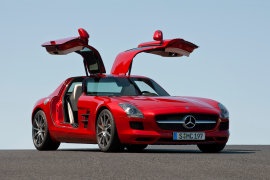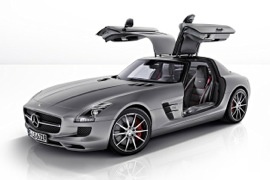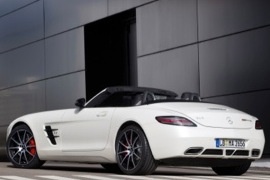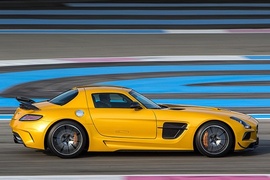
MERCEDES BENZ SLS AMG
Generations Timeline, Specs and Pictures

The new premium grand tourer SLS AMG was introduced at the 2009 IAA in Frankfurt.
The car will arrive at European dealers mid-2010 for an estimated price of 177.310 Euros. The SLS AMG was developed as a spiritual successor of the 300 SL “Gullwing”. It is the first car from the German manufacturer to be developed entirely by its racing division AMG. Although half-priced compared to the McLaren SLR, the SLS AMG, which fits somewhere between a premium grand tourer and a supercar, is meant to replace the aforementioned supercar. Powered by a naturally aspirated 6.2L V8 developing 571 HP, the SLS reaches 100 km/h (62 mph) in 3.8 seconds.

When someone mixed a Mercedes-Benz 300 SL “Gullwing” with a McLaren AMG SLR, the 2009 SLS AMG GT resulted.
In just three years, it evolved.
It is hard to look at an SLS AMG GT and not see the glorious past 300 SL from the mid-’50s. The Gullwing doors, long hood, and side vents on the front fenders are all icons from the past that kept the original supercar’s spirit alive. Other details were resembling the magnificent, 2003 SLR, a supercar inspired by the same charming and revolutionary coupe built by Mercedes-Benz.
In 2012, the German carmaker brought an enhanced version of the SLS. There was a new set of headlights and a new front grille with a slimmer slat to support the three-star badge. An additional GT badge was added to the trunk lid.
Inside, a new set of high-gloss black trims on the center console and the door panels were installed. The sport-bucket seats featured Alcantara on the middle segment, and the GT lettering embroiled on the headrests. An AMG instrument cluster was fitted with a black fascia, while the upshift indicator featured seven green LEDs.
The magic part was under the skin, where AMG tweaked the engine to offer 20 more ponies than its predecessor from the 6.2-liter V8 engine. It was paired to a 7-speed (dual-clutch) automatic gearbox. A newly developed suspension with more damping controls found its way inside the car.

Adding a roadster version to an already known supercar was never a bad idea, and Mercedes-Benz knew that.
When Mercedes-Benz started to build the Mercedes-AMG brand, it started with the SLS. A sports-car built by AMG, which had nothing in common with the rest of the German carmaker range. It was a huge success, and in the same year, it introduced the roadster version.
While its coupe brother could benefit from the “Gullwing” doors, the roadster had to use regular doors. The German designers faced the same problem with the original 300 SL, and it worked well. Without any hesitation, they bolted the new doors and chopped the roof. Some additional reinforcements were required, but those were planned since the SLS’s first lines were drawn. At the back of the car, the GT silver lettering on a red background was added before the AMG badge.
Inside, the designers added a new set of high-gloss black trims on the center console and the door panels. The sport-bucket seats featured Alcantara on the middle segment, and the GT lettering embroiled on the headrests. An AMG instrument cluster was fitted with a black fascia, while the upshift indicator featured seven green LEDs.
The magic part was under the skin, where AMG tweaked the engine to offer 20 more ponies than its predecessor from the 6.2-liter V8 engine. It was paired to a 7-speed (dual-clutch) automatic gearbox. A newly developed suspension with more damping controls found its way under the car.

Following legendary special edition models like the SLK 55 AMG Black Series, CLK 63 AMG Black Series, SL 65 AMG Black Series and the C 63 AMG Black Series, the SLS AMG is the first gull-winged model to feature the Black Series moniker.
Harking back to the successful SLS AMG GT3 race car, the fifth Black Series car from Mercedes-AMG is also the most track-focused car in the series. The 6.2-liter V8 used on both the standard SLS AMG and the GT3 race car has been massaged to offer even more power and torque, while the aluminum space frame comprising the chassis has been further lightened to give the SLS AMG Black Series a DIN curb weight of just 1,550 kilograms.
With no less than 631 horsepower at 7,400 rpm and 635 Nm of torque, the limited edition model is not only the most powerful but also the fastest accelerating Mercedes gull-wing car in history, with a 0-100 kph (62mph) time of just 3.6 seconds. The SLS AMG Black Series’ 2.45 kg/hp power-to-weight ratio is also the best compared with any other Black Series model to date. Various upgrades that benefit nimbleness have been made to the ultra-wide car, including the replacement of its aluminum torque tube with a carbon fiber one, installing the dual-clutch transmission lower into the chassis and replacing some components with much lighter versions.

While the original Mercedes-Benz SL was the fastest car in the world when it appeared, the SLS wasn’t.
But it was very fast and in the roadster version, the driver could hear the sound of the mighty V8 under that long hood much better.
What use of a big, loud, engine, that could scare the whole neighborhood if the driver cannot hear it properly? This, and maybe the roadster frenzy, made AMG build the SLS Roadster. Even if there are Mercedes-Benz badges on the wide grille and on the steering wheel, the car’s name is Mercedes-AMG, not Mercedes-Benz. The German car manufacturer had decided to transform AMG in a separate sub-brand to compete in Porsche’s segment, not with other premium cars like the old friend/foe BMW.
The outside look is purely a roadster. A very long hood, a short cabin and a little bit of trunk with short front and rear overhangs. The long hood was needed because the engine is midship installed, entirely behind the front axle. That made the car more balanced. The soft-top could open and close in just 11 seconds, close to the 11.5 seconds needed for the car to do a quarter-mile drag race.
Inside, the classic look of the instrument cluster is nicely done with two big round analog dials. The dashboard design is inspired by an airplane wing and the air-vents cruciform nozzles were reminiscent of jet engines. The infotainment system is placed on top of the center console and could be controlled via a rotary knob next to the armrest.
And yes, the most important part is the 571 hp, naturally aspirated engine that roars with a powerful note from the rear exhausts, which couldn’t be heard as clearly in the coupe version from the driver’s seat.























































